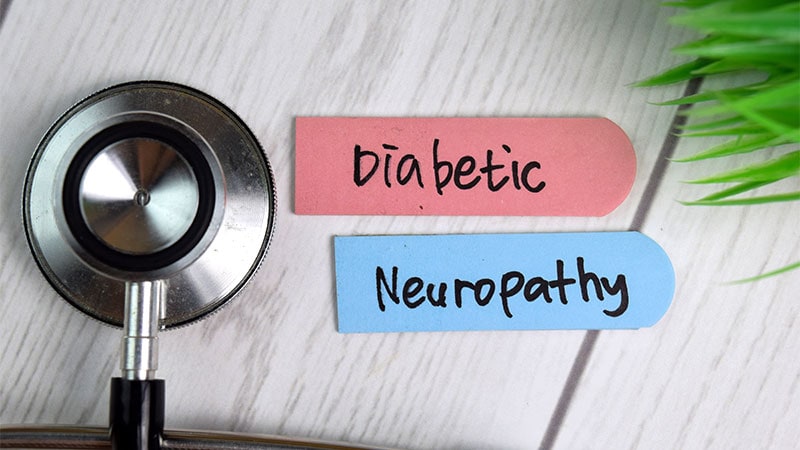TOPLINE:
In euthyroid patients with type 2 diabetes (T2D), relatively higher free triiodothyronine (FT3) levels within the normal range were linked to a lower risk for diabetic peripheral neuropathy and better nerve function.
METHODOLOGY:
- In euthyroid patients with T2D, lower FT3 levels within the normal range can worsen glucose and lipid metabolism and increase the risk for nephropathy and retinopathy, but the association of FT3 levels with peripheral neuropathy remains unclear.
- Researchers in China examined the relationship between FT3 levels and diabetic peripheral neuropathy in 1422 euthyroid patients with T2D (mean age, 58.04 years; 33.97% women) who underwent electromyography during hospitalization.
- Participants were considered euthyroid if their thyroid-stimulating hormone level was 0.25-5.5 IU/mL, free thyroxine level was 9.0-25.5 pmol/L, and FT3 level was 2.5-7.0 pmol/L.
- A diagnosis of diabetic peripheral neuropathy was made in those who showed neuropathic symptoms (neuropathic pain, paresthesias, numbness, sensory distortion, unsteadiness, or falls) and signs (pain sensation abnormalities, vibration sensation abnormalities, loss of the ankle reflex, touch/pressure sensation abnormalities, or temperature sensation abnormalities) during or after confirmed diabetes diagnosis.
- Nerve conduction studies of the distal limbs (median, ulnar, common peroneal, sural, and superficial peroneal nerves) were conducted in all participants, and distal motor and sensory nerve latencies, action potential amplitudes, and conduction velocities of motor and sensory nerves were recorded.
TAKEAWAY:
- Among all participants with T2D, the 519 who were diagnosed with diabetic peripheral neuropathy showed significantly lower serum FT3 levels than those without the condition (P < .001).
- The risk for diabetic peripheral neuropathy was reduced in participants with FT3 levels between 4.3 and 4.7 pmol/L (odds ratio [OR], 0.57; 95% CI, 0.39-0.81) and 4.7 and 7.0 pmol/L (OR, 0.33; 95% CI, 0.21-0.52) compared with those with FT3 levels between 2.5 and 3.8 pmol/L.
- Participants with neuropathy had slower, weaker nerve responses and longer latencies than those without, with higher FT3 levels in patients with diabetic peripheral neuropathy being linked to faster nerve conduction and shorter latencies.
- A Mendelian randomization analysis using the ThyroidOmics Consortium and the UK Biobank genome-wide association study data also indicated a causal relationship between low FT3 levels and the risk for diabetic peripheral neuropathy (inverse variance weighted β = -0.655; P = .035).
IN PRACTICE:
“Within the normal range, a relatively high level of FT3 (> 4.3 pmol/L) was associated with a reduced risk of DPN [diabetic peripheral neuropathy]. Thyroid hormones may be beneficial for patients with DPN if their FT3 levels are near the low end of the normal range,” the authors of the study wrote.
SOURCE:
This study was led by Bing’er Xu, Department of Endocrinology, Zhongshan Hospital, Fudan University, Shanghai, China. It was published online in the Journal of Clinical Endocrinology and Metabolism.
LIMITATIONS:
This study was limited by its single-center design and focused on hospitalized patients with T2D in Shanghai. It measured only specific peripheral nerves’ conduction parameters. The Mendelian randomization analysis was conducted only in Europeans, requiring validation in other ethnic populations.
DISCLOSURES:
This study received support from the National Science and Technology Major Project, the National Natural Science Foundation of China, the Science and Technology Commission of Shanghai Municipality, and other sources. The authors reported having no conflicts of interest.
This article was created using several editorial tools, including AI, as part of the process. Human editors reviewed this content before publication.
Source link : https://www.medscape.com/viewarticle/low-ft3-levels-predict-risk-nerve-damage-diabetes-2025a1000l7u?src=rss
Author :
Publish date : 2025-08-11 11:07:00
Copyright for syndicated content belongs to the linked Source.
